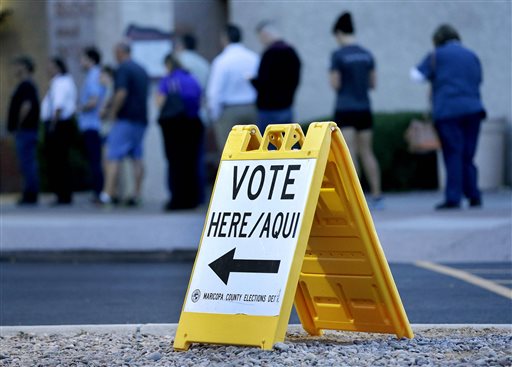The Department of Justice is investigating the decision by election officials in Maricopa County, Arizona, to reduce the number of polling places by about two-thirds ahead of a presidential primary that was wrought with turmoil.
Elizabeth Bartholomew, a spokesperson for Maricopa County Recorder Helen Purcell, the county’s top election official, confirmed to TPM Monday that the local elections agency had received a letter from the feds Friday requesting the data the county used when it decided to set up only 60 vote centers. That the office had received the letter was first reported by the Huffington Post.
Phoenix Mayor Greg Stanton had sent a letter to the Department of Justice requesting an investigation in which he argued that minority communities were disproportionately affected by the distribution of the vote centers.
Last month’s Arizona presidential primary made headlines for the chaos at polling places particularly in Maricopa County, the most populous county in the state. Voters waited for upwards of five hours to cast their ballots, which many blamed on the Arizona’s transition to the 60 vote centers, down from more than 200 polling precincts in 2012.
Voters also reported that they had not been properly registered for a political party, as is required in Arizona’s presidential preference election, as well as complications with the polling e-books, which were supposed to help administrators check in voters as they waited in line.
County officials said decision to use the 60 vote centers was motivated in part to save the county money. Vote centers — which allow voters to vote at any of the locations rather than just the single precinct they are assigned to — have been rolled out without issue in other states, prompting critics to wonder what kind of analysis the county did when deciding where and how many centers to set up.
Before the Supreme Court gutted the Voting Rights Act in 2013, the county’s decision would have been vetted by federal officials, as Arizona was covered under the VRA’s “preclearance” section before the Supreme Court invalidated a key provision in it.
In an interview with TPM last week, Bartholomew laid out Maricopa’s logic for offering only 60 vote centers.
She said that the county had 2 million active voters, but 750,000 were registered as independent or were unaffiliated with a party, and thus were ineligible to vote in the presidential primary. Out of the roughly 1.2 million voters left over, 890,000 had been sent mail-in ballots, she said, either because they were on a permanent mail-in ballot list or because they requested one specifically for this election.
Of the remaining 340,000, county officials assumed a turnout rate similar to the 2008 election — the last time both parties had contested primaries — of 22 percent, Bartholomew said. She said using that logic, the county believed 60 vote centers would be enough to handle an average of 1,200 to 1,500 voters that they expected would show up at each.
“We tried to hit the major areas, it really wasn’t enough. The number 60 was simply not enough,” she said.










